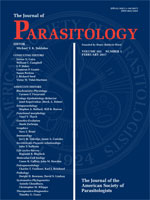Cichlidocestus n. gen. is proposed to accommodate 2 new species of proteocephalidean cestodes, Cichlidocestus gillesi n. sp. from Cichlasoma amazonarum in Peru (type species) and Cichlidocestus janikae n. sp. from Hypsophrys nicaraguensis (all Perciformes: Cichlidae) in Costa Rica. The new genus is unique among all but 1 proteocephalidean genera in the position of the ovary that occupies the middle and posterior thirds of the median region of proglottids (vs. the ovary in the posterior third of proglottids near their posterior margin in all but 1 remaining taxa). In addition, Cichlidocestus is typified by the presence of a voluminous, spherical, internal seminal vesicle, several pairs of ventral excretory canals in the medulla, a pyramidal, quadrilobed scolex with an apical muscular sucker, and the posterior extent of the testes that may reach almost to the posterior margin of proglottids. The new genus shares the position of the ovary and its extension with Sciadocephalus (also a parasite of cichlids in the Neotropics as the new taxon); in all remaining proteocephalideans the ovary occupies the posterior third only. Sciadocephalus differs from Cichlidocestus by a different morphology of the scolex, which possesses an umbrella-like metascolex that is markedly wider than the strobila, the number of ventral osmoregulatory canals, and development of the uterus, which forms capsule-like formations filled with eggs in Sciadocephalus megalodiscus (vs. simple lateral diverticula in Cichlidocestus spp.). Both new species of Cichlidocestus can be easily distinguished from one another by the anterior extent of the poral vitelline follicles (anterior to the cirrus-sac, i.e., preporal, in C. gillesi vs. posterior, i.e., only postporal in C. janikae), size of the eggs (diameter of the external layer of the embryophore of C. gillesi 30–33 μm vs. 44–46 μm in C. janikae), and the number of uterine lateral diverticula (16–21 on 1 side in C. gillesi vs. only 8–12 in C. janikae) and the testes (37–46 in C. gillesi vs. 63–74 in C. janikae). Based on a phylogenetic analysis of the 28S rRNA gene (lsrDNA) sequences, C. gillesi forms a lineage sister to S. megalodiscus, thus supporting the morphological similarity of both genera that occur in fishes of the same family in the same zoogeographical region.
How to translate text using browser tools
1 February 2017
A New Genus and Two New Species of Proteocephalidean Tapeworms (Cestoda) from Cichlid Fish (Perciformes: Cichlidae) in the Neotropics
Alain de Chambrier,
Carlos Daniel Pinacho-Pinacho,
Jesus Servando Hernández-Orts,
Tomáš Scholz
ACCESS THE FULL ARTICLE

Journal of Parasitology
Vol. 103 • No. 1
February 2017
Vol. 103 • No. 1
February 2017




